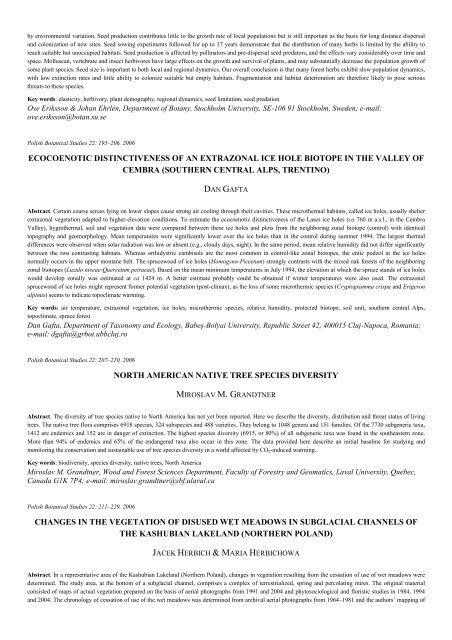Polish Botanical Studies 22 (2006)
Polish Botanical Studies 22 (2006)
Polish Botanical Studies 22 (2006)
Create successful ePaper yourself
Turn your PDF publications into a flip-book with our unique Google optimized e-Paper software.
y environmental variation. Seed production contributes little to the growth rate of local populations but is still important as the basis for long distance dispersal<br />
and colonization of new sites. Seed sowing experiments followed for up to 17 years demonstrate that the distribution of many herbs is limited by the ability to<br />
reach suitable but unoccupied habitats. Seed production is affected by pollinators and pre-dispersal seed predators, and the effects vary considerably over time and<br />
space. Molluscan, vertebrate and insect herbivores have large effects on the growth and survival of plants, and may substantially decrease the population growth of<br />
some plant species. Seed size is important to both local and regional dynamics. Our overall conclusion is that many forest herbs exhibit slow population dynamics,<br />
with low extinction rates and little ability to colonize suitable but empty habitats. Fragmentation and habitat deterioration are therefore likely to pose serious<br />
threats to these species.<br />
Key words: elasticity, herbivory, plant demography, regional dynamics, seed limitation, seed predation<br />
Ove Eriksson & Johan Ehrlén, Department of Botany, Stockholm University, SE-106 91 Stockholm, Sweden; e-mail:<br />
ove.eriksson@botan.su.se<br />
<strong>Polish</strong> <strong>Botanical</strong> <strong>Studies</strong> <strong>22</strong>: 195–206, <strong>2006</strong><br />
ECOCOENOTIC DISTINCTIVENESS OF AN EXTRAZONAL ICE HOLE BIOTOPE IN THE VALLEY OF<br />
CEMBRA (SOUTHERN CENTRAL ALPS, TRENTINO)<br />
DAN GAFTA<br />
Abstract. Certain coarse screes lying on lower slopes cause strong air cooling through their cavities. These microthermal habitats, called ice holes, usually shelter<br />
extrazonal vegetation adapted to higher-elevation conditions. To estimate the ecocoenotic distinctiveness of the Lases ice holes (ca 760 m a.s.l., in the Cembra<br />
Valley), hygrothermal, soil and vegetation data were compared between these ice holes and plots from the neighboring zonal biotope (control) with identical<br />
topography and geomorphology. Mean temperatures were significantly lower over the ice holes than in the control during summer 1994. The largest thermal<br />
differences were observed when solar radiation was low or absent (e.g., cloudy days, night). In the same period, mean relative humidity did not differ significantly<br />
between the two contrasting habitats. Whereas orthidystric cambisols are the most common in control-like zonal biotopes, the entic podzol at the ice holes<br />
normally occurs in the upper montane belt. The sprucewood of ice holes (Homogyno-Piceetum) strongly contrasts with the mixed oak forests of the neighboring<br />
zonal biotopes (Luzulo niveae-Quercetum petraeae). Based on the mean minimum temperatures in July 1994, the elevation at which the spruce stands of ice holes<br />
would develop zonally was estimated at ca 1424 m. A better estimate probably could be obtained if winter temperatures were also used. The extrazonal<br />
sprucewood of ice holes might represent former potential vegetation (post-climax), as the loss of some microthermic species (Cryptogramma crispa and Erigeron<br />
alpinus) seems to indicate topoclimate warming.<br />
Key words: air temperature, extrazonal vegetation, ice holes, microthermic species, relative humidity, protected biotope, soil unit, southern central Alps,<br />
topoclimate, spruce forest<br />
Dan Gafta, Department of Taxonomy and Ecology, Babeş-Bolyai University, Republic Street 42, 400015 Cluj-Napoca, Romania;<br />
e-mail: dgafta@grbot.ubbcluj.ro<br />
<strong>Polish</strong> <strong>Botanical</strong> <strong>Studies</strong> <strong>22</strong>: 207–210, <strong>2006</strong><br />
NORTH AMERICAN NATIVE TREE SPECIES DIVERSITY<br />
MIROSLAV M. GRANDTNER<br />
Abstract. The diversity of tree species native to North America has not yet been reported. Here we describe the diversity, distribution and threat status of living<br />
trees. The native tree flora comprises 6918 species, 324 subspecies and 488 varieties. They belong to 1048 genera and 151 families. Of the 7730 subgeneric taxa,<br />
1412 are endemics and 152 are in danger of extinction. The highest species diversity (6915, or 80%) of all subgeneric taxa was found in the southeastern zone.<br />
More than 94% of endemics and 65% of the endangered taxa also occur in this zone. The data provided here describe an initial baseline for studying and<br />
monitoring the conservation and sustainable use of tree species diversity in a world affected by CO 2-induced warming.<br />
Key words: biodiversity, species diversity, native trees, North America<br />
Miroslav M. Grandtner, Wood and Forest Sciences Department, Faculty of Forestry and Geomatics, Laval University, Quebec,<br />
Canada G1K 7P4; e-mail: miroslav.grandtner@sbf.ulaval.ca<br />
<strong>Polish</strong> <strong>Botanical</strong> <strong>Studies</strong> <strong>22</strong>: 211–<strong>22</strong>9, <strong>2006</strong><br />
CHANGES IN THE VEGETATION OF DISUSED WET MEADOWS IN SUBGLACIAL CHANNELS OF<br />
THE KASHUBIAN LAKELAND (NORTHERN POLAND)<br />
JACEK HERBICH & MARIA HERBICHOWA<br />
Abstract. In a representative area of the Kashubian Lakeland (Northern Poland), changes in vegetation resulting from the cessation of use of wet meadows were<br />
determined. The study area, at the bottom of a subglacial channel, comprises a complex of terrestrialized, spring and percolating mires. The original material<br />
consisted of maps of actual vegetation prepared on the basis of aerial photographs from 1991 and 2004 and phytosociological and floristic studies in 1984, 1994<br />
and 2004. The chronology of cessation of use of the wet meadows was determined from archival aerial photographs from 1964–1981 and the authors’ mapping of
















